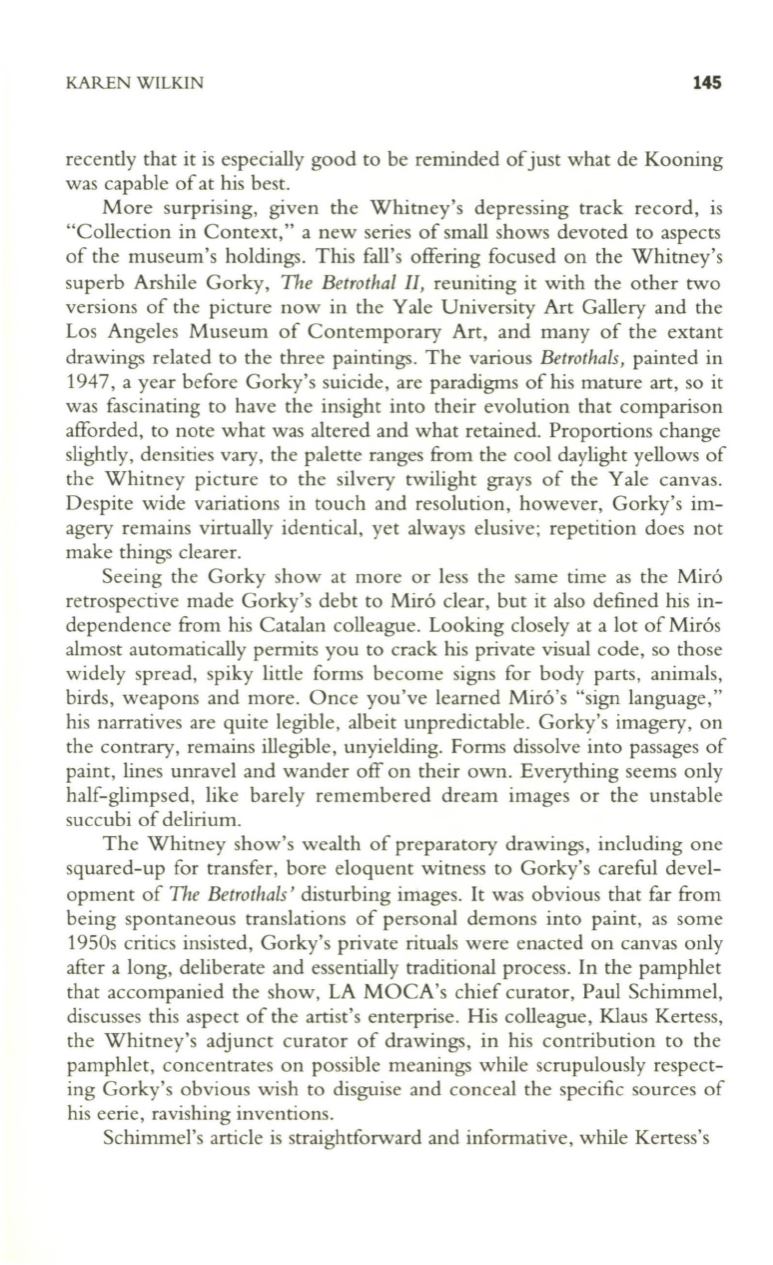
KAREN WILKIN
145
recently that it is especially good to be reminded ofjust what de Kooning
was capable of at his best.
More surprising, given the Whitney's depressing track record, is
"Collection in Context," a new series of small shows devoted to aspects
of the museum's holdings. This fall's offering focused on the Whitney's
superb Arshile Gorky,
The Betrothal II,
reuniting it with the other two
versions of the picture now in the Yale University Art Gallery and the
Los Angeles Museum of Contemporary Art, and many of the extant
drawings related to the three paintings. The various
Betrothals,
painted in
1947, a year before Gorky's suicide, are paradigms of his mature art, so it
was fascinating to have the insight into their evolution that comparison
afforded, to note what was altered and what retained. Proportions change
slightly, densities vary, the palette ranges from the cool daylight yellows of
the Whitney picture to the silvery twilight grays of the Yale canvas.
Despite wide variations in touch and resolution, however, Gorky's im–
agery remains virtually identical, yet always elusive; repetition does not
make things clearer.
Seeing the Gorky show at more or less the same time as the Mir6
retrospective made Gorky's debt to Mir6 clear, but it also defined his in–
dependence from his Catalan colleague. Looking closely at a lot of Mir6s
almost automatically permits you to crack his private visual code, so those
widely spread, spiky little forms become signs for body parts, animals,
birds, weapons and more. Once you've learned Mir6's "sign language,"
his narratives are quite legible, albeit unpredictable. Gorky's imagery, on
the contrary, remains illegible, unyielding. Forms dissolve into passages of
paint, lines unravel and wander off on their own. Everything seems only
half-glimpsed, like barely remembered dream images or the unstable
succubi of delirium.
The Whitney show's wealth of preparatory drawings, including one
squared-up for transfer, bore eloquent witness to Gorky's careful devel–
opment of
The Betrothals'
disturbing images.
It
was obvious that far from
being spontaneous translations of personal demons into paint, as some
1950s critics insisted, Gorky's private rituals were enacted on canvas only
after a long, deliberate and essentially traditional process. In the pamphlet
that accompanied the show, LA MOCA's chief curator, Paul Schimmel,
discusses this aspect of the artist's enterprise. His colleague, Klaus Kertess,
the Whitney's adjunct curator of drawings, in his contribution to the
pamphlet, concentrates on possible meanings while scrupulously respect–
ing Gorky's obvious wish to disguise and conceal the specific sources of
his eerie, ravishing inventions.
Schimmel's article is straightforward and informative, while Kertess's


